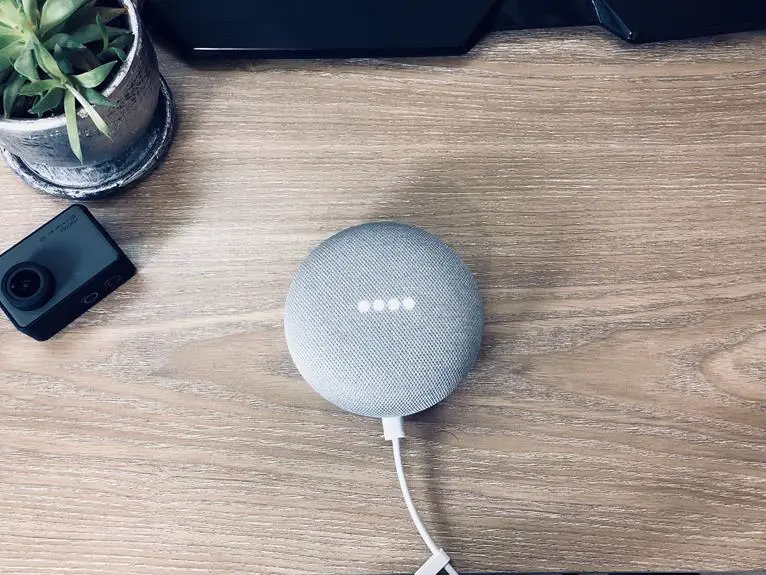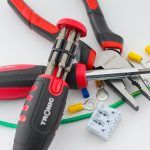Are you tired of dealing with a tangled mess of cables in your home office? Studies show that the average person spends 4.3 hours per week untangling cords and cables.
Take control of your workspace and boost your productivity by mastering the art of cable management. Declutter your desk, select the right organizers, and label and color-code your cables for easy identification.
Utilize cable management tools and smart placement techniques to keep your cords neat and organized. Regular maintenance and checks will ensure that your cable management system remains efficient.
With these tips, you can create a clean and organized home office environment that promotes focus and efficiency.
Key Takeaways
- Clear desk of unnecessary items
- Use cable organization tools to manage and conceal cords
- Label and color-code cables for easy identification
- Utilize cable management trays and furniture with integrated cable management for a neat and organized workspace
Declutter Your Workspace
Declutter your workspace by removing unnecessary items and untangling cords for a more organized and efficient home office setup. Workspace organization is crucial for a productivity boost.
Start by clearing your desk of any items that aren't essential for your daily work. Keep only the tools and supplies you use frequently within arm's reach. This will create a more ergonomic setup, reducing the need to twist and turn to reach things while working.
Invest in cable organization tools to manage and conceal cords. Tangled cables not only look messy but can also be a hazard and cause distractions. Use cable clips, zip ties, or cable sleeves to keep cords neat and tidy. This simple step won't only improve the aesthetics of your workspace but also contribute to a more focused and efficient work environment.
Choose the Right Cable Organizers
Invest in cable organizers that suit your specific needs and workspace layout to effectively manage and conceal cords for a tidy and hazard-free home office. When choosing the right cable organizers, consider the following options:
- Cable Management Boxes: These sleek boxes are perfect for concealing power strips and excess cables, keeping them neatly tucked away and out of sight. Look for ones with multiple openings for easy access and ventilation to prevent overheating.
- Cable Clips and Ties: These handy desk accessories are ideal for keeping individual cords organized and preventing them from tangling. Use adhesive cable clips to secure cords along the edges of your desk, while reusable cable ties are great for bundling together longer cords.
- Cable Management Sleeves: For a more streamlined look, consider using cable management sleeves to bundle and hide multiple cords together. These sleeves are flexible and can be easily cut to the desired length, offering a clean and organized solution for cord management in your home office.
Label and Color-Code Your Cables
To enhance the organization of your cables, it is important to label and color-code them for easy identification and maintenance. Color coded organization and cable labeling techniques are essential for keeping your cables tidy and manageable. When labeling your cables, use a system that is easy to understand and maintain. Here's a simple table to demonstrate a color-coding and labeling system for different types of cables:
| Cable Type | Color Code | Label |
|---|---|---|
| Power | Red | PWR-01, PWR-02, etc. |
| Ethernet | Blue | ETH-01, ETH-02, etc. |
| HDMI | Green | HDMI-01, HDMI-02, etc. |
| USB | Yellow | USB-01, USB-02, etc. |
| Audio/Video | Orange | AV-01, AV-02, etc. |
Utilize Cable Management Tools
When organizing your cables in your home office, consider using cable management tools to keep them neatly arranged and easily accessible. Cable organization is essential for a clean and efficient desk setup, and there are several tools available to help you achieve this in your home environment.
- Cable Ties: Invest in high-quality reusable cable ties to secure and bundle together loose cables. These ties are adjustable and can be easily removed and reused, making them an ideal solution for organizing cables of varying lengths.
- Cable Raceways: Utilize cable raceways to conceal and protect cables running along your walls or desk. These are especially useful for home environments where aesthetics are important, as they can keep cables neatly tucked away and prevent tripping hazards.
- Cable Management Boxes: Consider using cable management boxes to store and organize excess cables and power strips. These boxes not only keep cables out of sight but also protect them from dust and potential damage, contributing to a tidy and safe home office setup.
Implement Smart Cable Placement
When arranging cables in your home office, consider concealing cords creatively. This can be done by using cable clips to hold the cables together and keep them out of sight. Another helpful tip is to label your cables neatly, so you can easily identify them when needed. These smart placements and labeling techniques can help you maintain a tidy and organized workspace.
Conceal Cords Creatively
Start by carefully positioning your cables along the back edge of your desk. This allows for a tidy and organized appearance, while also keeping cords within easy reach when needed.
To conceal cords creatively, consider the following innovative organization and stylish solutions:
- Use Cable Management Trays: Install discreet cable management trays underneath your desk to keep cords off the floor and neatly organized.
- Incorporate Hidden Storage: Utilize furniture with integrated cable management and hidden storage compartments to keep cables out of sight while maintaining easy access.
- Cable Clips and Ties: Employ cable clips and ties to bundle and route cables along the edges of furniture, such as your desk or shelving, creating a sleek and organized look.
Use Cable Clips
To effectively manage cable clutter, position your cables strategically and secure them in place using cable clips for smart and organized placement. Cable clips are essential desk accessories for cable organization and home improvement. By using cable clips, you can prevent cables from tangling and keep them neatly organized, enhancing the overall visual appeal of your workspace. Here's a table to help you choose the right cable clips for your needs:
| Cable Clip Type | Features | Recommended Use |
|---|---|---|
| Adhesive Clips | Easy to install | Ideal for lightweight cables |
| Magnetic Clips | Convenient placement | Perfect for metal surfaces |
| Screw-in Clips | Secure attachment | Great for permanent setup |
When implementing smart cable placement with cable clips, you'll achieve a clutter-free and efficient workspace.
Label Cables Neatly
Label each cable with clear and specific tags to ensure easy identification and organized placement. Neat cable arrangement and tidy cable organization are crucial for maintaining a clean and efficient home office setup. Here's how to label your cables effectively:
- Use color-coded labels: Assign a specific color to each type of cable, such as blue for Ethernet and yellow for power cords. This makes it easy to identify cables at a glance.
- Include clear descriptions: Label each cable with its purpose and the devices it connects. For example, 'Monitor Power' or 'Router Ethernet.'
- Place labels near both ends: Ensure that labels are visible from both the device and the power source, making it simple to trace cables without having to follow them from end to end.
Maintenance and Regular Checks
Now that you have your cables organized, it's important to keep up with regular maintenance and checks.
Regular cable inspections will help you catch any issues before they become major problems.
Implement preventive maintenance tips and schedule routine checks to ensure your cable management system stays efficient and reliable.
Regular Cable Inspections
Begin by regularly inspecting all your cables for wear and tear, ensuring they're functioning properly and safely.
Regular cable inspections are essential for maintaining a well-organized and safe home office. Follow these steps to keep your cables in top condition:
- Create an inspection schedule: Set aside time every month to thoroughly check each cable for any signs of damage or wear.
- Test cable functionality: Plug and unplug each cable to ensure they're working as intended. This will help you identify any loose connections or faulty cables.
- Reorganize as needed: Use this opportunity to adjust your cable management system, ensuring that cables are neatly organized and free from tangles or hazards.
Preventive Maintenance Tips
To effectively maintain your home office cable management, regularly conducting preventive maintenance checks is crucial. Consistent cable organization and maintenance will ensure that your home office remains free from potential hazards and operational disruptions.
Start by visually inspecting cables for any signs of wear, such as fraying or exposed wires. Check that all cables are properly secured and not tangled or twisted.
Additionally, it's important to clean and dust cables and connectors regularly to prevent any buildup that could affect their performance.
Make it a habit to schedule regular checks, perhaps monthly or quarterly, to ensure that your cable management system is in optimal condition. By staying proactive with cable maintenance, you can minimize the risk of unexpected issues and maintain a tidy and efficient home office setup.
Scheduled Check Routines
Regularly conduct scheduled maintenance checks to ensure that your cable management system is consistently in optimal condition, minimizing the risk of unexpected issues in your home office. Here are three essential steps for maintaining an organized and efficient cable management system:
- Visual Inspection: Take a few minutes every week to visually inspect all cables, connectors, and cable trays for signs of wear, damage, or disorganization. This simple routine can help you identify potential issues before they escalate.
- Cable Labeling: Regularly check the labels on your cables to ensure they're still legible and accurate. Over time, labels can fade or become illegible, leading to confusion and inefficiency.
- Cable Untangling: Set aside time every month to untangle any cables that may have become twisted or knotted. This not only maintains an organized appearance but also prevents potential electrical hazards.
Frequently Asked Questions
How Can I Prevent My Pets From Chewing on My Cables?
To prevent pet chewing on cables, pet proofing is essential. Use cable protectors to cover and secure cords. Ensure all loose cables are tucked away or hidden behind furniture. Consistency in redirecting pets and providing alternative chew toys is key.
Are There Any Eco-Friendly Cable Management Options Available?
You can explore eco-friendly solutions for cable management by opting for organizers made from sustainable materials such as bamboo, recycled plastic, or fabric. These options not only help declutter your space but also minimize environmental impact.
Can I Use Cable Management Tools for Outdoor Cables?
Yes, you can use weatherproof management tools for outdoor cables, providing cable protection and serving as animal deterrents. Ensure the tools are designed for outdoor use to effectively manage and protect your outdoor cables.
How Can I Prevent Dust and Debris From Accumulating in My Cable Organizers?
To prevent dust and debris from accumulating in your cable organizers, regularly clean and dust the area where the cables are stored. Consider using cable management tools that offer protective covers to shield the cables from dust and debris.
Are There Any Options for Hiding Cables in Hard-To-Reach Areas?
You can conceal cables in hard-to-reach areas by using cord protectors and hiding them in hidden spaces. This ensures both cable concealment and protection while keeping them out of sight and organized.




